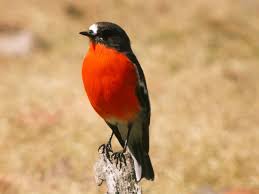Flame robin
(Petroica phoenicea)

Description
The flame robin (Petroica phoenicea) is a small passerine bird native to Australia.It is a moderately common resident of the coolest parts of south-eastern Australia,including Tasmania.Like the other two red-breasted Petroica robins—the scarlet robin and the red-capped robin—it is often simply called the robin redbreast.Like many brightly coloured robins of the Petroicidae,it is sexually dimorphic.Measuring 12–14 cm (4.7–5.5 in) long,the flame robin has dark brown eyes and a small thin black bill.The male has a brilliant orange-red chest and throat,and a white patch on the forehead above the bill.Its upper parts are iron-grey with white bars,and its tail black with white tips.The female is a nondescript grey-brown.Its song has been described as the most musical of its genus.The position of the flame robin and its Australian relatives on the passerine family tree is unclear;the Petroicidae are not closely related to either the European or American robins but appear to be an early offshoot of the Passerida group of songbirds.The flame robin is predominantly insectivorous,pouncing on prey from a perch in a tree,or foraging on the ground.A territorial bird,the flame robin employs song and plumage displays to mark out and defend its territory.Classified by BirdLife International as Near Threatened,the species has suffered a marked decline in the past 25 The largest of the red robins,the flame robin is 12–14 cm (4.7–5.5 in) long.It has a more slender build than other members of the genus Petroica,with relatively long wings and neck and small head.The male is easily distinguished by the bright orange-red plumage of the throat,breast and abdomen.The crown,nape,ear coverts,hindneck,and sides of neck are dark grey,and lores and chin are a grey-black.The grey feathers of the sides of the crown may be suffused with dull orange.The rest of the upperparts,comprising the wings,back and tail,are dark grey.There is a small white frontal spot above the bill,and the wing bar and outer tail shafts are white.The feathers of the posterior belly,flanks and vent are white with grey-black bases.The female is plainly coloured—pale brown overall,and a lighter buff underneath.The posterior belly,flanks and vent are off-white.As in the male,feathers on the side of the crown may be suffused with a dull orange,and this may also occur with breast feathers.There are small off-white marks on the wings and above the bill.The bill,legs,feet and claws are black,and the eyes dark brown.A flame robin with an all lemon-yellow breast and otherwise female plumage was observed in a small flock of flame robins near Swansea in eastern Tasmania in September 1950. Nestlings have dark grey or brown down,cream to grey bills,cream gapes and orange throats.The plumage of juvenile birds in their first moult resembles that of the adult female,but the head and upperparts are streaked and slightly darker.Soon after fledging,juveniles moult into their first immature plumage,and more closely resemble the adult female.The breasts of male birds may have some orange feathers.Birds in their second year moult into a second immature phase,some males of which may resemble adult males,while others retain a more immature brown plumage.Determining the age and sex of birds in brown plumage can be very difficult.Information on exact timing of moulting is lacking,but the replacement of primary feathers takes place over the summer months between December and February.The colour alone is not a reliable guide to determine the species,as some scarlet robins (P.boodang) take on an orange hue,but while male scarlet and red-capped robins (P.goodenovii) have red breasts and black throats,the flame robin's breast plumage extends right up to the base of the bill.It is also a little slimmer and has a smaller head than the scarlet robin,and is clearly larger than the red-capped.Females of the respective species are harder to tell apart.Those of red-capped,rose and pink robins are all smaller,with wing lengths less than 7 cm (2.8 in),smaller than the smallest flame robin.The female scarlet robin has a more pronounced red flush to the breast and the spot on the crown above the bill is more prominent and white rather than off-white.The flame robin's calls are grouped into louder and quieter calls;the former can be heard from 150 m (490 ft) away,the latter,which are often briefer,from 30 m (98 ft).Loud songs make up almost 90% of calls in spring,summer and autumn,but less than 50% of calls from May to July.Males sing rarely during this time,although they do so to defend their territories.Their song is more varied and complex than that of the scarlet robin,and has been described as the most musical of the red robins.A series of descending notes in groups of three,the musical song has been likened to the phrases,"you-may-come,if-you-will,to-the-sea" or "you-are-not a-pretty-little-bird like-me".Both males and females sing this song,often perched from a vantage point such as a stump or fence.This loud song is used to attract the attention of a potential mate,and to announce the bringing of food to its mate or young.The softer call has been described as a tlip,terp or pip and is used as a contact call in the vicinity of the nest.The female makes a hissing sound if approached while on the nest,and the male has been recorded making a wheezing call when displaying around the nest
Taxonomic tree:







